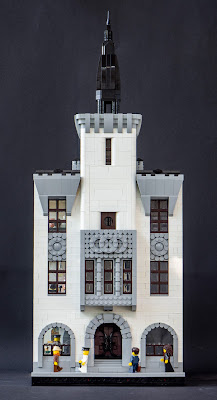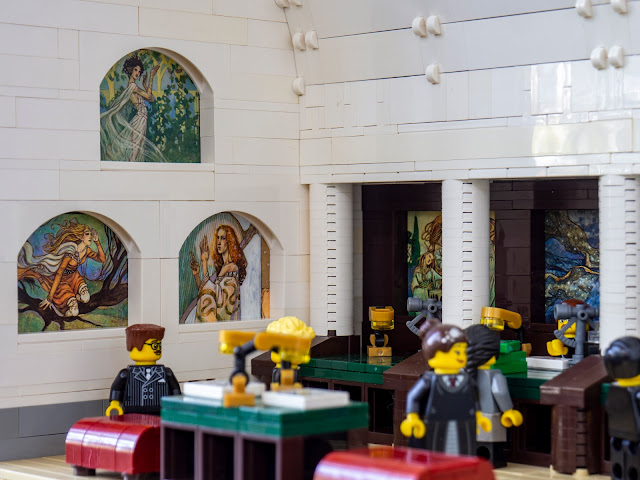This was my entry for Palikkatakomo ry's commercional building summer contest. The subject was simply a commercional building with footprint from 16x16 to 64x64. I had a clear intention from the beginning - to build my own version of architect office Gesellius, Lindgren, Saarinen's Pohjoismaiden Osake-Pankki bank from 1903-1904. I wanted to make a cross section of the banking hall and the vertical main facade. So the building is practically a three-dimensional axonometric cross-section. I haven't usually built interiors to my modulars, but I've grown interest in them, too, and this is the first finished one. I've got a much bigger, similar project in progress, too - as it has been for a year now.

So this was my starting point. I did not want to copy the exact building or drawing, but to make my own version of it. Firstly, I had chosen to make the model 64x32 studs in size - 64x64 would have been too big job for the time I had got. This meant I had to abandon two of the five window axises, and the facade worked pretty nicely with these three vertical elements. I made a relatively finalised facade drawing (in Tikkurila train station and in train from there to Tampere) with measures - 3-4-3-4-4-4-3-4-3, 32 in total. The first-floor arches are made with tooth plates, soemthing I've wanted to try for a while. The tower has same smooth shapes than in Kudelma hotel, and stone armament... cheats a bit, mathematically, but works pleasantly nevertheless. I'm particularly happy with the stone ornaments between the 2nd and 3rd floor windows.
The frescoes of the bankin hall are not Lego so this is not purist work (gasp!). Our LUG's contest rules allow up to 1 % non-Lego-stuff in entries, and this one uses seven Magic the Gathering cards, illustrated by Rebecca Guay, much-adored artist of vintage Magic. Her work is very fitting for this jugendstil/Art Nouveau period, reminding of Alphonso Mucha or even Tampere-based Joseph Alanen. There cards - Samite Blessing, Sky Spirit, Dwell on the Past, Pulse of Llanowar, Quirion Trailblazer, Devout Harpist and Calming Verse - vary from unplayable to relative weak; but every one of them have beautiful art and I believe they work better here than in any of my decks. The art is almost exactly 6 studs wide, which made the integration very easy. The cards were not harmed during the build, they're simply contained inside the walls.

In addition to the hall, some of the spaces of the street building are cut and visible. The sturcture is unrealistically thin, but there are limits on what can be done in two weeks in 32x64 plot! On the first floor there is the bank manager's office, with tile stove based on a model designed by Valter Thomé around 1903; it was originally built for another project, but didn't quite fit. The third floor has the break room for bank staff, featuring a smaller stove. The first floor has simply a vestibyle leading to the banking hall, kept warm with a soapstone stove.
-Eero























0 comments :
Post a Comment
Note: Only a member of this blog may post a comment.